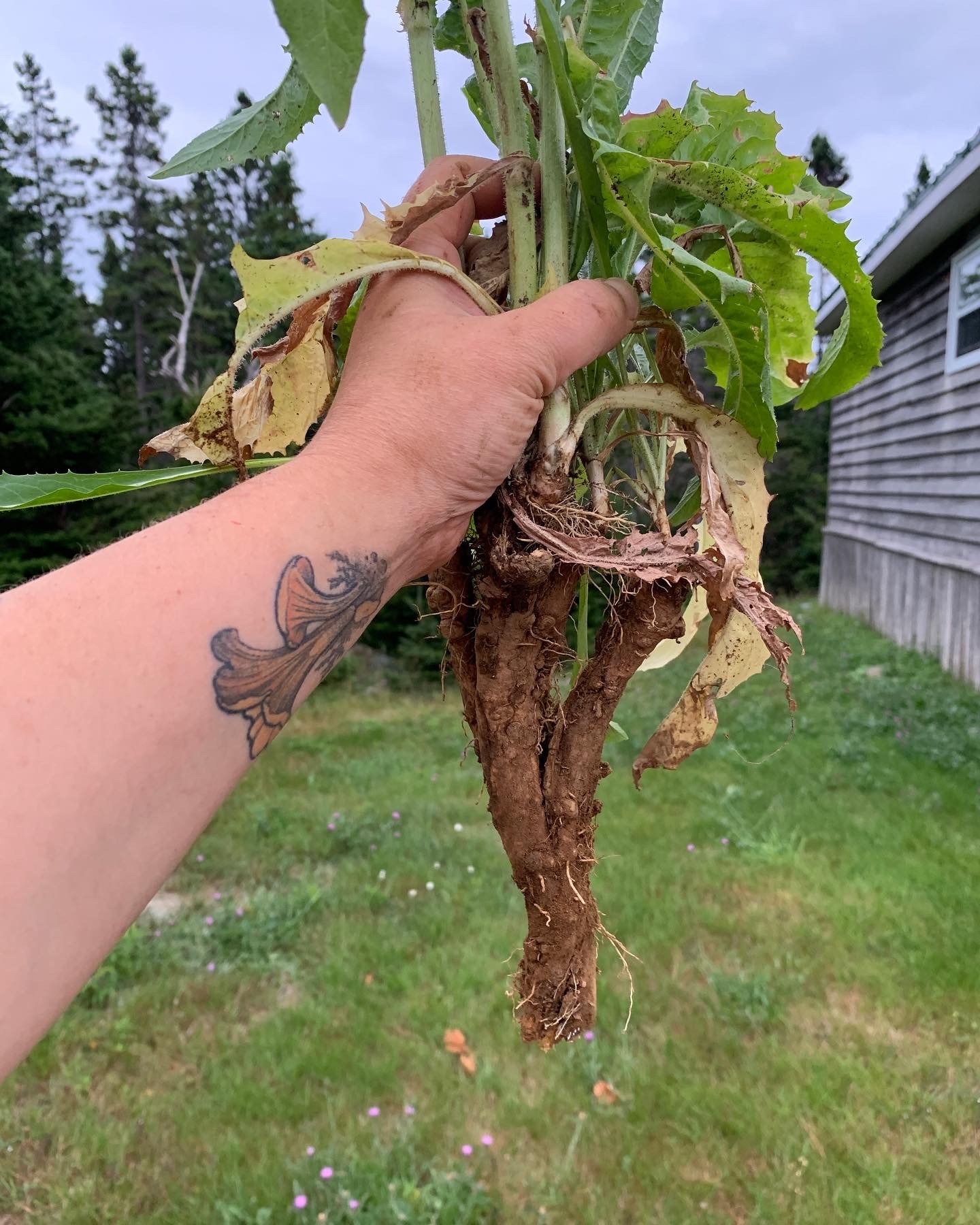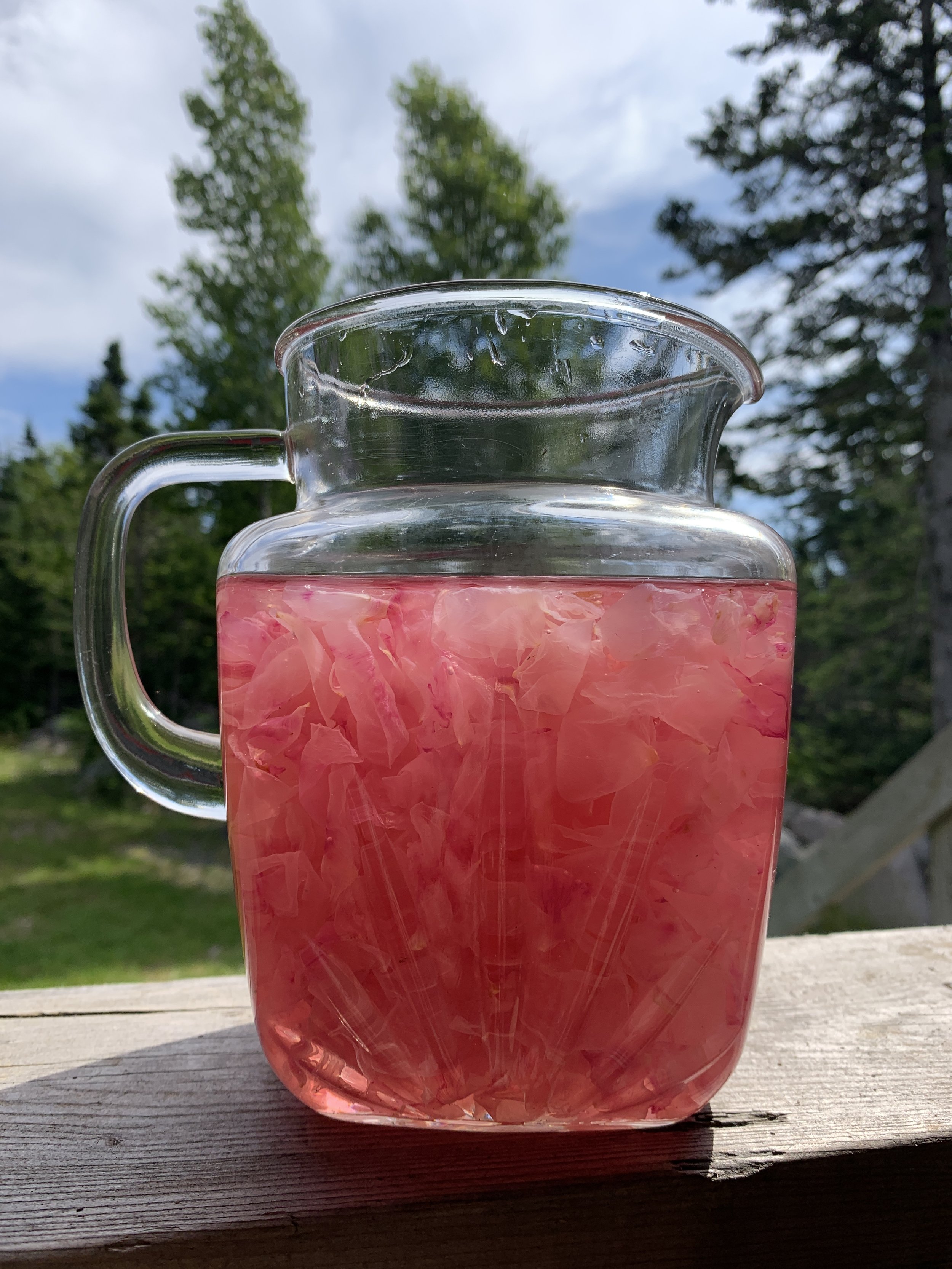Foraged Beverages
Rose Lemonade
Most delicious drinks start off with a simple syrup. You can use fresh or dehydrated roses / edible flowers, although dehydrated plants often produce an even deeper colour and more robust flavour.
You can make a great syrup with one cup of rose petals. If you have quality food grade rose water, even better.
I don’t use a 1:1 ratio of water and sugar with a syrup meant for lemonade. If you need it to be thick like syrup (for a glaze, for example), or you really like it sweet, follow the 1:1 ratio. I usually use 1 cup sugar and 2 cups water and rely mostly on the rose flavour and the citrus to make this drink refreshing.
Add your water and rose petals to a pot, stir until sugar is dissolved and it comes to a boil. Turn burner down slightly and let it boil for 10 minutes. If using additional rose water, add it in at this point and boil for another 3-5 minutes. At this point I usually add a bit of citrus (a mix of lemon AND lime is great), and take it off the heat to cool.
I don’t boil my syrups with the citrus in them so not to dull or destroy the fresh taste of the lemon or lime. Watch as the colour of your syrup intensifies even more once you add your citrus juices!
Add your syrup to a pitcher or jar and fill with water and more lemon and/or lime juice. Keep adjusting to taste. Refrigerate.
Bunchberry Tea
Bunchberry / Cornus canadensis is a small woody shrub which is part of the Dogwood family. Also called ‘Dolleyes’. It grows in forested areas and spreads widely and quickly. This amazing plant is something we would want to sip on if we are congested, have a raspy or sore throat, clogged sinuses, etc.
The tea we tried was harvested from the property and was made from both the berry and the leaves and root, and can be fresh or dehydrated. What we tried was a mix of both dehydrated leaves and fresh berries, leaves and roots. Simmered in water for 30 minutes. I brewed this for a gentle taste but many drink it daily to keep common cold symptoms at bay - in this case, make a stronger version.
Chaga Chai Latte
Chaga was harvested in Wreck Cove - so much of it, everyone gets some chaga to take home!
This drink was prepared by brewing several small chunks of chaga for about 45 minutes at a simmer. Deeper boiling can extract different nutrients than just a gentle simmer, but I was looking to simmer to taste for this recipe.
I separately made a strong chai tea (put together by a neighbor) and added them together with the chaga water, vanilla, maple syrup to taste. I added oat meal, shook it up and put it in the freezer for a bit before serving. Great over ice!
Lemongrass, Pineappleweed & Ginger Iced Tea
Lemongrass was grown by my neighbour, pineappleweed from here in Wreck Cove. I made sure to pick this plant in areas with no pollutants, heavy traffic, pets, etc. I grabbed the flowers only and I gave them a thorough washing and patted them dry, making the simple syrup shortly after.
First I brought a medium pot to boil with water and dehydrated lemongrass, then I added the fresh pinappleweed and the sugar. I only added half of the sugar (1 cup) to about 4 cups of water, plus these ingredients - I wanted to finish it off once it was cooler with raw honey (from my bee hives!). Note: most people use more sugar than I do, but I like it a little less sweet and a bit more tangy.
I later added shredded ginger once I liked the taste level of the pineappleweed and reduced a bit further to make the syrup. Once it reduced a bit I took it off of the element to cool. Once it was warm but not hot, I added 3/4 cups of raw honey.
I brewed 4 black tea bags to about 8 cups of water earlier which was now cool. I added the tea and the now cold simple syrup together, plus several lemon/limes worth of juice and some zest. I left this overnight and strained it when I was ready to serve.
Chicory Root Decaf “Coffee”
This was really fun to try but it also requires lots of work! Digging the chicory root out of the ground is a task on its own but I enjoyed this process and recommend trying it.
Once the root was dug, I cleaned off dirt and wash and dried them. I then cut them up into pretty small chunks to prepare them for roasting. After digging them out of the ground and then washing them, they were pretty moist. I dehydrated them slightly in an airfryer while I got the oven ready (about 30 mins). This step was taken to avoid having to roast them for hours and it worked.
I got the heads up on the dehydrating step from this video on youtube.
I baked on a low temp of 200 degrees for about 1.5 hours. When they came out, I wished I dug more root because they were awfully small! I had a decent amount and we enjoyed it mixed with a little bit of decaf coffee so there was enough for everyone. I enjoyed the bitter taste and it added an earthy depth to the coffee.





